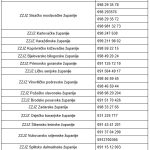From economic measures and FINA’s desire to look good to issues of transparency and public spending, Marko Rakar takes a look at the post-coronavirus future for Croatia on the portal mrak.org.
April the 12th, 2020 – If you read the news (at least the international news), you’ve likely read that Americans reported an additional 6.2 million unemployed people yesterday, which means that about 17 million people have become unemployed in the past three weeks. From that perspective, that’s about 10 percent of the total number of employees, and the question is: How come they have such an explosive growth of unemployed people, and there is so much less of that here in Croatia?
The workforce in Croatia (depending on who is counting, and how they’re doing that counting) could be between 1.5 and 1.7 million (the criteria for the number of employees is somewhat unclear, as some self-employed activities and OPGs are not always part of these statistics), but let’s say that this is about 1.7 million people, which is a mere 1 percent of the American workforce. Similarly, if we were to follow those trends, we would have to register about 170,000 unemployed people, and today we’re closer to 17,000 (which can be clearly seen on Index.hr), which is 1/10 of what has happened over in America.
We can certainly find some of the answers to this in the Croatian Government’s measures as companies try to look at how permanent this situation might be, or what the overall effects of it will be on their businesses. Another, far greater factor (at least as I see it) are our labour laws which, among other things, provide for notice periods that are very lavish when compared to those in the US. If you rewind the film just a little bit, then you will know that the last day of school was March the 13th, 2020, while quarantine (or lockdown or whatever we like to call this situation) took effect on March the 23rd, 2020. Assuming that the typical ”termination period” [at work] is one month, it’s to be expected that those who have been laid off from the 13th of March onwards, will start going to the Croatian Employment Service only next week, and then we’ll start to get a true, clear picture of the state of unemployment in Croatia.
There’s no doubt that a huge number of people will end up going or have already gone to the Croatian Employment Service, and since the coronavirus pandemic has caught us right in the middle of Croatia’s usual ascending cycle of seasonal employment, it is to be expected that these seasonal workers will not be able to find a job even along the coast, and due to the current, general prohibitions on cross-border movement, they won’t be able to find a job abroad either (I wrote about the lack of seasonal workers in agriculture and the effect on the availability and rise in prices of certain agricultural products in the weeks to come earlier).
These seasonal workers are people who have jobs that are their elemental existence and the ongoing coronavirus situation for them is unfortunately not good at all. It’s worth remembering that famous thirty percent that makes up the ”grey” economy, the grey economy is not only made up of hospitality workers doing jobs ”under the table” or just criminals, but also entire social groups (for example, those who have had their bank accounts blocked), and who have no alternative whatsoever but to work ”on the black”.
In these circumstances of forbidden movement, halting the general economy but also suspending all investments (think of small building projects along the coast, various pieces of construction in continental Croatia, or those assisting “on the black” in various trades and companies) – these people have been left without any, even illegal income, and as such – they will further slip towards poverty.
I think we’re collectively underestimating the effects of the coronavirus-induced economic crisis we have run into at full speed. Until now, economic crises (and depressions) were entered slowly and gently, so much so that we did not realise for a long time what had actually happened, and this is a completely different situation now.
The real question is, and many people are discussing it, at what point can we begin to approach anything that resembles our lives before the aforementioned Friday the thirteenth of March, 2020?
If you look at this document (PDF) from the Boston Consulting Group, and if we look at Croatia’s neighbouring countries or countries where the spread of coronavirus is somewhat similar to our situation, I think there is no doubt that it will not be possible to start facilitating movement before the second week of June.
It also means that we’ve not even reached the midpoint of the coronavirus crisis yet, and the question is, what will life look like in two months? ECB President Lagarde said last week that every month, lockdown means 2-3 percent of GDP less, and that figure, in Croatia’s specific circumstances, should probably be multiplied by some factor, and all together, that needs to be multiplied to find out what the hole in the state budget will be.
Going back to facilitating isolation measures, we’ll be hearing a lot about the examples of Austria, Denmark or the Czech Republic where they decided to start implementing these anti-epidemic measures earlier, but one should be very careful that what happened to Singapore doesn’t happen here. Singapore, although it seemed to, didn’t manage to address the spread of the coronavirus epidemic. The situation here in Croatia is very similar and most of those infected could be accompanied by a specific “importer” of the virus, but the last few days, and with the breakthrough of the virus into Croatian nursing homes and hospitals, don’t really give us much reason for satisfaction.
The situation in Singapore is also interesting because the Croatian authorities, in an attempt to install a mass surveillance system, cite the example of Singapore as a good example where a monitoring application reportedly successfully helped stop the spread of the coronavirus epidemic.
Well, new facts have just arrived and they don’t sound so great. The South Korean example also shows signs of “fatigue” and it’s worth repeating once again that there’s not even an indication of how such applications are actually helping to solve any problems, while violating the right to privacy and freedom from control in the most spectacular way (which I wrote about for Index). I wouldn’t want to be petty right now, but all of a sudden we have a whole new set of applications and solutions (for example, there’s the one from the civil protection staff for the issuance of passes), so, I’m interested, in the spirit of GDPR, who exactly is leading this, who will have access to the information we need to provide, why, and for how long?
It’s clear to me that this is a perceived public good (though if 1/6 of the population has passes, their very existence should be called into question), but there are nevertheless some legal frameworks from which one should not ”jump” – just like the one that sees that the decisions and the scope of those decisions made by the national [civil protection] headquarters are not within the law. How has that been missed by the powerful lawyers employed by the state and the public sector?
Of course, transparency criteria is also worth mentioning. Namely, a lot of things have been suspended during this time and the urgency of doing this is because of a whole lot of various purchases of any equipment and materials that are necessary in the fight against this coronavirus monster.
Nevertheless, it’s necessary that the state, the public sector, and especially these locals (from Milan Bandic onwards), supply the true costs of this disaster to the public, and that they do so in real time. There’s no excuse or reason for not doing so. We can start with the koronavirus.hr website itself, and we don’t actually know who manages it (I know that sounds irrelevant and petty but…), they’re not able to share the data in a machine-readable format one month later (I think this is intentional because they themselves have to have this information but they don’t want to share it).
And then there is all the other information that might be interesting, such as the question of testing (why are we testing how much are we testing, as our tactics seem different from many). What are the reasons for this, is there a problem with materials (reagents, I’m not an expert so I don’t know…) or is there another reason? Who are we procuring them from, and at what price?
And then, we can move on to the subsidy measures, where I’m forced to agree with the unions and say that they should publicly write which company has received money, how much money, and for what number of employees they money is for (and there is a logic to the request that the companies seeking a ban on dividend payments in the forthcoming period, similar to the way banks did, note that the EU recommended the non-payment of dividends while the Croatian National Bank and HANFA prohibited the payment of dividends – I feel some litigation and damages are on the horizon).
Transparency would help to identify any sort of abuse very quickly, and it would also discourage those who are thinking of resorting to some sort of blackening of public money. Unfortunately, transparency and public insight into the spending of public money isn’t exactly popular in our area. It will be interesting to see if these payments are seen on the Ministry of Finance’s website (which I conceived a long time ago, although my idea and this realisation don’t have much to do with each other, but that’s how it is when a bureaucratic mind reads instructions).
What I think we’ll see with the anti-coronavirus economic measures of the Croatian Government (and somehow it seems to me that we need to read very carefully and differentiate the expected effects of the measures from the real money being pumped into the system) is that we’ve done a lot to make sure the measures of economic aid, that would by all criteria need to be really fast, simply aren’t.
Lending through HBOR, HAMAG and who knows which other institutions (including banks) involve time-consuming administrative processes that are subject to scrutiny and review and of course decisions. In an environment where there will be thousands or even tens of thousands of such requests, it’s difficult to expect the administrative apparatus to be able to keep up, so these measures, if they come and are approved, will come too late for many.
The absolute winner in creating meaningless services is of course FINA (they’re also a safe bet in normal circumstances), they created a website where you can sign up for some coronavirus economic measures. They are not an implementing body, they don’t decide on anything, and with the information they collect for nothing known to them they do absolutely nothing but pass it on to the bank or institutions mentioned above. Why anyone would do this rather than contact their bank directly is totally unclear. The geniuses at FINA probably realised that they, too, needed to do something, even if it was something completely pointless. The mere impression of them doing something is everything.
On the other hand, the state is digitising ys radically, and now that contact with clients is a potentially dangerous task, suddenly, all at once, everything can be done via the Internet or by email. Let’s just hope the team documents what it’s doing, because later it won’t be possible to unravel what happened once something does come to a halt.
Thought of the day:
When faced with a radical crisis, when the old way of being in the world, of interacting with each other and with the realm of nature doesn’t work anymore, when survival is threatened by seemingly insurmountable problems, an individual life-form — or a species — will either die or become extinct or rise above the limitations of its condition through an evolutionary leap.
This text was written by Marko Rakar, was first published on mrak.org, and was translated from Croatian into English by Lauren Simmonds
For more on coronavirus in Croatia, follow our dedicated section.











